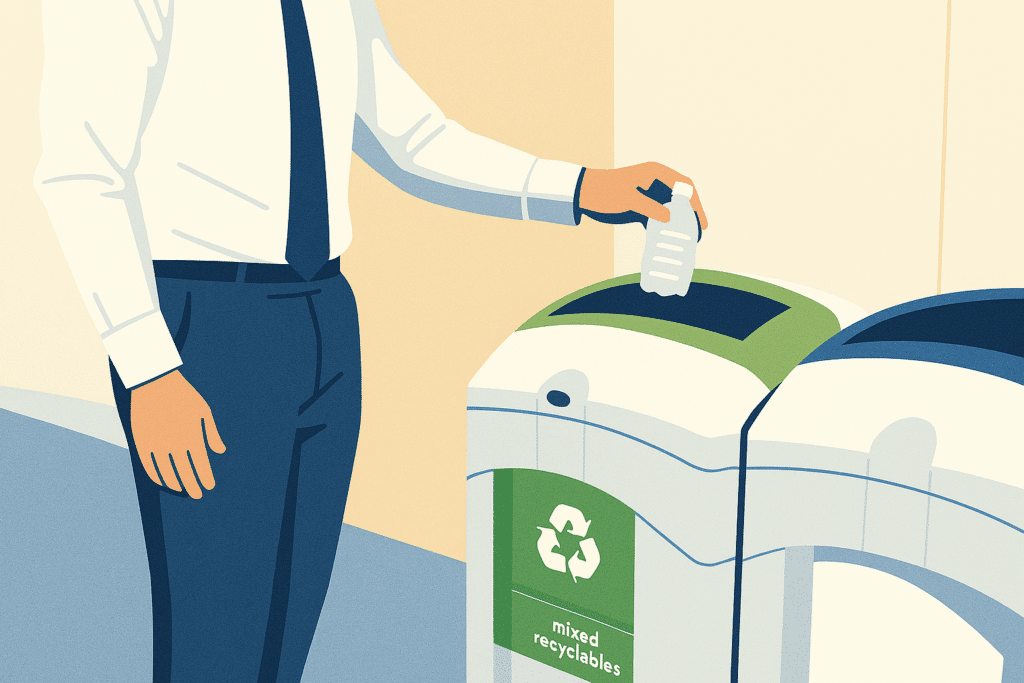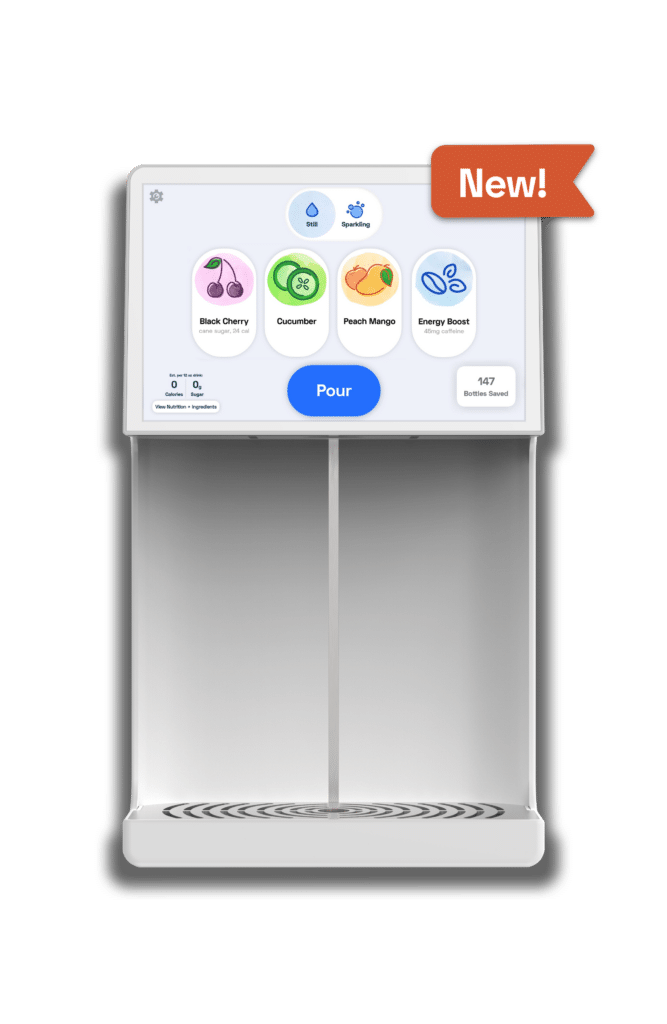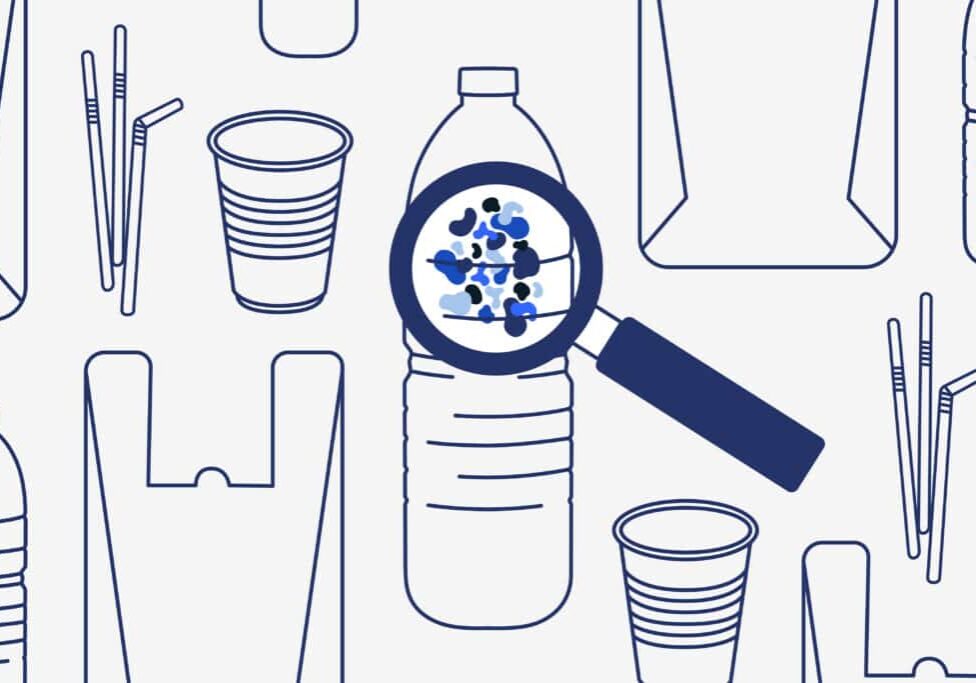Last updated July 14, 2025. How could you possibly avoid microplastics in the office when there’s so much disposable plastic waste going around?
It’s an average morning at work and you’re sitting there going through your emails and as you’re sipping on a hot coffee in a styrofoam cup, the teammate working nearby tosses his first plastic water bottle of the day in the trash bin under his desk.
At the same time, someone around the corner is changing the printing cartridges and throwing the used ones away while someone else opens an energy bar wrapper in the breakroom.
You go to write something down on your notepad but the pen has gone dry, so you throw it like a basketball at a bin across the room. Swish!
The amount of single-use products that office workers use in a single day can really be astonishing
For someone who works in an office, the average amount of waste they generate is 4.4 pounds per day. Then if you consider the number of people who work office jobs, the amount of waste created becomes almost unfathomable.
Much of this waste can actually be recycled but the current infrastructure and patterns of behavior in most American offices has left us with a waste-generation problem. Recently the issue of microplastics, a symptom of the disease that is plastic waste, is creating serious health risk issues for humans across the globe, potentially including yourself.
Microplastics are everywhere
Anything that you use in your office that is made with plastic materials (e.g. pens, plastic bottles and cups, cutlery, coffee pods, etc.) either ends up in a landfill or sewage. In that landfill, the plastics break down into tiny pieces about the size of sesame seeds or even smaller (5mm or less in length). These are microplastics and from the landfill, these small but mighty plastic shards leak out of landfills and end up washed into nearby waterways such as rivers and ponds.
Water filtration systems fail to stop these harmful materials from reentering our lives. They eventually make their way via those waterways into the oceans and lakes, into the fish and other animals that we consume, the water that we drink and even into the air that we breathe.
Humans can come into contact with microplastics through ingestion, inhalation, and skin contact, and can cause health issues like cancer, organ failure, diabetes, neurological and reproductive issues, amongst others. These microplastics are pervasive across the globe and scientists don’t fully understand the extent of this problem or the long term impacts they could have on human health and the environment. What scientists do know, however, is that these materials are extremely harmful to marine life in the short-term, this puts an essential nutritional resource to many cultures across the globe at risk.
A filtration system that removes microplastics from water
While you may think that you can avoid microplastics simply by not eating fish, unfortunately, that is not the case. Researchers at the University of Victoria in Canada analyzed microplastics levels in the bodies of various people and found the biggest sources of microplastic to be not only from seafood but also from the air they were breathing and bottled water they were drinking. That’s right, bottled water! The very thing that is breaking down and creating the microplastic problem in the first place.
An article in Time magazine states, “when people drink their water only from bottled sources, they ingest about 90,000 microplastic particles every year from that water, but people who drink only tap water get 4,000 of such particles a year”.
This fact is shocking and certainly has left us with a distrust of bottled water here at Bevi. Because we know that microplastics are harmful to our bodies, we need to start to reduce the amount that we are allowing to enter the environment and ultimately our food chain. It is not enough to simply get better at recycling single-use plastic products. We also need to work at not creating them in the first place.
Workspaces and offices are one of the largest sources of plastic pollution and there are so many ways these spaces can be altered to be better for the environment and better for the health of their employees. Read on!

How to avoid microplastics in the office: 5 steps to follow
Office managers and eco-friendly workplace warriors can really help when it comes to combating the issue of plastic waste and microplastics.
Initially, there might be some investment needed in order to move away from things like single-use plastic forks and spoons and toward reusable silverware that is much better for the environment. There may be other hurdles to overcome, such as not having a good recycling program in your area. There may also be some pushback from co-workers initially, who are used to having their iced coffee in plastic cups every day or who just don’t see the urgency in changing their behavior. Here are some steps you can take to reduce the amount of plastic waste coming from your office and in turn you will be helping to reduce the amount of microplastics in your surrounding environment. Ultimately your company and your co-workers will thank you.
1. Find some inspiration
There are so many great zero-waste influencers on social media these days and they are helping to teach others about all of the great DIY projects and eco-friendly products they use in order to reduce the amount of waste they generate. You can follow a lot of these folks on Instagram such as the waterthruskin and get inspired to go waste-free yourself. Follow accounts like zero.waste.collective that provide tips on things like creating a zero-waste dishwashing routine. That’s something you could implement in the office!
2. Trash audit for plastics
In order to make changes, one often has to find the urgency to do so. There is no way to find the urgency unless you know how much you are actually wasting. A good way to do this is an office-wide trash audit. It can be eye-opening and will spark behavior change amongst your co-workers.
In order to do this, take a trash bin from different parts of the office including the break room, the printer room, conference room, or whatever other rooms you may have. Dump it out and with gloves on go through it, and write everything that you find in there on a whiteboard or piece of paper. If there is more than one of something, for example, multiple plastic cups, just put extra tally marks next to that item on your list.
If you’re noticing one type of garbage taking up most of the space in the bin, you might try to make that the first thing you try to switch from disposable to reusable. You can even share with the rest of the company what you found, and give them the heads up that there might be some small changes coming their way.
3. Make the easy switches
To get buy-in, tell the people in your office why these changes are important and thank them for working with you to make your office healthier and more sustainable.
Start a BYOB initiative and encourage people to bring their own reusable coffee cup and/or a reusable water bottle. If your company can, a good way to discourage the use of disposable plastic products is by supplying team members with company-branded water bottles or travel mugs. Plus, when they’re using the cups out-of-office, these can serve as free advertisements for your business!
Motivate team members to pack lunch from home and avoid eating out. This might be difficult to get everyone to do, but try tying this initiative in with a healthy-eating initiative. Something that would help start this process would be to make sure you have a refrigerator where your co-workers can store their lunches, and perhaps even a dishwasher if possible. Employees can go one step further and bring bamboo or metal cutlery and their own reusable straws. Every little thing helps!
The most important part of this part of the process is raising awareness across the company. Choose someone to spearhead and be the face of the zero-waste initiative. You can incentivize your co-workers by putting different teams in competition with one another to see who can reduce their plastic waste the most in the upcoming months.
4. Amenities: better for employees, the environment & your budget
Now that you got everyone using their reusable coffee mugs and water bottles, it’s time to take things up another level.
There are tons of innovative products on the market that are specifically meant to reduce the amount of office waste that a business might generate. Bevi is an awesome way to inspire employees to refill their bottles all day long and save office managers from the stress of restocking shelves with beverages.
With a Bevi machine, your co-workers can completely customize their beverage with carbonation or different flavors. This makes the hydration experience throughout the workday much more exciting and generally reduces the amount of dehydrated and angry people in the office.
Depending on the number of employees you have in the office (and their thirst level), a Bevi machine is often cheaper than continuing to buy and stock tons of single-use seltzer cans or plastic water bottles. Additionally, if you have anyone coming to the office, the Bevi is a fun way to entertain your guests while also providing them a delicious and healthy beverage.
5. Recycling Programs
Recycling is not standardized throughout the US and often much of what we think we’re recycling ends up in landfills anyway. Some cities are better at recycling than others, so it’s important that if you are trying to become zero-waste in the office, you should research the recycling programs for your general area.
If you find that the recycling programs in your area are inadequate, there is a company called TerraCycle who is ready to help you! TerraCycle has various programs and products aimed at eliminating the idea of office waste. The Break Room Separation Zero Waste Box™ is a good way to collect all of the recyclable material from your breakroom. TerraCycle will provide you with points that can be redeemed for various prizes or exchanged for money toward a charity of your choice.
We spend so much of our lives in our workplaces and within those spaces, we each generate a huge amount of waste. Most of that is plastic waste that ends up as harmful microplastic particles that could harm the health of our employees and co-workers later down the line. Shouldn’t we all be taking steps to reduce the amount of waste we generate during the workday?






